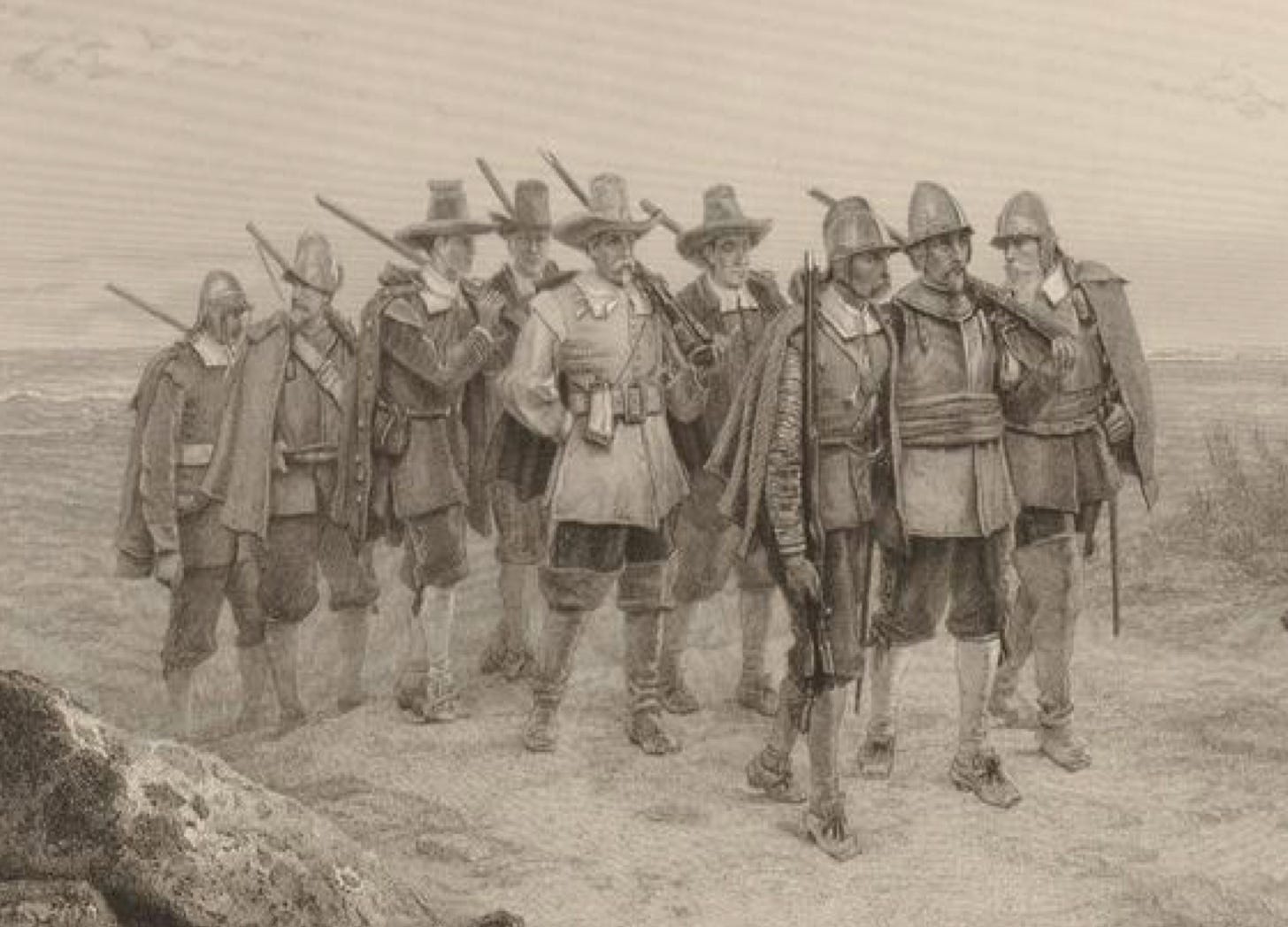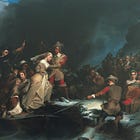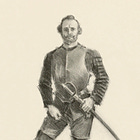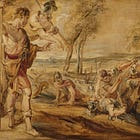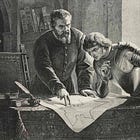On 14 August 1621, Myles Standish led a fourteen-man patrol to the village of Nemasket, a Wampanoag settlement some fourteen miles west of the recently established colony of New Plymouth. As there was no way to reach Nemasket by boat, Captain Standish and his musketeers made the journey on foot.
The patrol owed its existence to a report that Squanto, the English-speaking Wampanoag who had served as the colony’s translator for the past five months, had been captured, and perhaps even killed, by a high-ranking Wampanoag named Corbitant. (Corbitant, it seems, wished to ‘make Algonquins great again’.)
With this in mind, the governor of New Plymouth, William Bradford, gave Standish a two-pronged mission. If it turned out that Squanto was alive, the captain was to rescue him. If, however, he found conclusive evidence that Corbitant had murdered the interpreter, he was to deprive the culprit of his head.

When the patrol reached Nemasket, people there reported that Corbitant had been staying in a particular wigwam. Standish posted his men around the dwelling, with orders to prevent the escape of anyone who tried to leave it, and entered therein.
Standish found neither Squanto nor Corbitant. He did, however, frighten the people inside the wigwam, causing them to flee. In the moments that followed, the musketeers of New Plymouth wounded three of the ‘runners’.
In the aftermath of this brief altercation, Standish learned that Corbitant had left the village for parts unknown and that Squanto, who had not been killed, had also departed without leaving a forwarding address. The captain therefore apologized to the three wounded Wampanoags and told them that, if they traveled to New Plymouth with the returning patrol, the colony’s physician would treat their wounds.
Though the one medical man in New Plymouth, Samuel Fuller, had received little, if any formal training in the healing arts, his treatments bore good fruit. Thus, after several weeks of English hospitality and Mr. Fuller’s physic, the three wounded Wampanoag experienced complete recoveries.
The injuries to the three people in Nemasket might well have been caused by something other than bullets. If, however, the damage resulted from rounds fired by the musketeers, the fact that the people struck were able to walk for fourteen miles within hours of being hit tells us something about the projectiles involved.
Full-bore bullets fired by shoulder arms of the early seventeenth century varied greatly in size. The smallest, with a diameter of half-an-inch (12 millimeters) might weigh as little as an ounce (28 grams). The largest, which fit a weapon with a one-inch (25 millimeter) bore, could tip the scales at two ounces (56 grams). The bullets at the far ends of this spectrum, however, were built for somewhat specialized weapons - whether carbines optimized for ease of carry or massive muskets built for shooting at mighty war horses and their steel-plated riders.
While many of the men who bore them would have bridled at the metaphor, the shoulder arms of Plymouth colony seem to have followed a via media that ran between these two extremes. That is, they probably fired projectiles with weights in the neighborhood of one and a third ounces (37 grams) and diameters of three-quarters of an inch (19mm) or so. (Some of these were muskets built to military specifications. Others were fowling pieces optimized for shooting at birds with a good deal of meat on them.)

The effect of a full-bore bullet fired by one of these weapons can be seen in the following account of the mortal wound inflicted upon King Gustav Adolph of Sweden in 1632, and thus a mere eleven years after the incident at Nemasket.
The ball struck, and split the King’s left arm in such a way that blood spurted out of it, and bone could be seen through his clothes. ‘The King bleeds’, shouted the Swedes. ‘It is nothing, My Children’, advance’ cried Gustavus Adolphus, as he tried to hide his shock behind a brave face. Soon, however, overcome by pain and the loss of blood, he leaned towards the Duke of Lauenburg, and asked him, in French, to remove him, with discretion, from the battlefield.The bullets fired at Nemasket may well have grazed their victims, or, thanks to the distance that they flew, spent much of their energy in flight. I think, however, that the simplest explanation for the injuries inflicted on the ‘walking wounded’ concerns the size of shot used. That is, rather than preparing for battle by charging their pieces with full-bore musket balls, the men of New Plymouth had loaded each of them with several smaller projectiles.
The colonists may have done this for reasons of logistics. While the most advanced armies of the day had begun to standardize the calibers of their shoulder arms, the Englishmen who crossed the Atlantic on the Mayflower made do with a motley collection of muskets and fowling pieces that, while superficially similar, differed greatly in particulars. Thus, if he wished to obtain a full-sized musket ball that fit properly in the barrel of his weapon, a colonist would have been obliged to cast it himself.
I suspect, however, that the arsenal at New Plymouth lacked many of the bespoke bullet molds required to turn molten lead into properly proportioned projectiles. Thus, men armed with muskets or fowling pieces would have been obliged to resort to such workarounds as trimming of bullets with a knife or loading each weapon with well-wadded shot of smaller sorts.
While the former required a good deal of time, the latter offered the advantage of putting each musketeer in a position to fire upon any goose, duck, or turkey he might encounter in the course of his travels. Moreover, while the men of New Plymouth seem to have done quite a bit of close order drill, complete with the firing of blank cartridges, most of the live rounds that they fired in earnest would have been aimed at creatures of the avian persuasion.
Evidence for the use of smaller shot can be found in a report of a visit, in June of 1621, of an embassy from New Plymouth to Sowams, the town that served as the capital of the Wampanoag confederation. When asked to demonstrate the use of their muskets, the escorts of the diplomats fired ‘haile-shot’ against the targets set out for them, thereby filling them full of holes. Soon after this incident, the author of that account wrote a list of items that people who wished to join the colony at New Plymouth should take with them to the new world. This catalogue, which included a ‘musket or fowling piece’ for each man, concluded with ‘let your shotte be most for bigge fowles’.
Sources:
The account of the wounding of Gustavus Adolphus comes from Johann Heilmann Das Kriegswesen der Kaiserlichen und Schweden zur Zeit der dreißigjärigen Krieges [The Military Methods of the Imperialists and Swedes in the Era of the Thirty Years War] (Leipzig: F.W. Goedsche, 1850) page 395
The account of the shooting ‘haile-shot’ at a target, the story of the fight at Nemasket, and the advice related to ‘shotte’ for ‘bigge fowles’ come from Edward Winslow A Relation or Journal of the beginning and proceedings of the English Plantation settled at Plymouth in New England (London: John Bellamie, 1622) pages 46, 53-56, and 64
A separate account of the Nemasket patrol can also be found in William Bradford History of Plymouth Plantation (Boston: Massachusetts Historical Society, 1856) pages 103-104
For Further Reading:




